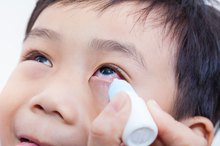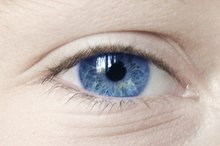Itchy, irritated eyelid margins are a common complaint. The eyelid margins contain the eyelash follicles and several types of glands that lubricate the lashes and nearby skin, and contribute to the tear film that keeps the eyeball surface moist. Several eye disorders can lead to itchiness and irritation of the lid margins, including blepharitis, dry eye syndrome and eye allergies. Some of these conditions frequently occur concurrently.
Anterior Blepharitis
Blepharitis refers to inflammation of the eyelids, which encompasses several different conditions. Anterior blepharitis affects the front of the eyelid margin, including the base of the eyelashes and their follicles, and the adjacent eyelid skin. Characteristic signs and symptoms include eyelid margin itchiness and redness, and flakes or crusts in the lashes.
A staphylococcal bacterial infection is the most common culprit for this anterior blepharitis. Infestation of the eyelash follicles and eyelid glands by a microscopic mite called Desmodex is another common cause of this condition. Seborrheic dermatitis involving the eyelids can also cause anterior blepharitis. This chronic skin condition typically causes a flaky rash and itchiness, and commonly involves the scalp, eyebrows, eyelids and ear canals.
- Blepharitis refers to inflammation of the eyelids, which encompasses several different conditions.
- Seborrheic dermatitis involving the eyelids can also cause anterior blepharitis.
Posterior Blepharitis
Causes of White Eye Discharge
Learn More
Posterior blepharitis describes inflammation of the inner edge of the eyelid, behind the eyelash follicles and adjacent to the surface of the eyeball. This condition almost always involves abnormal function of the meibomian glands, and commonly triggers itchiness and irritation of the eyelid margins. The meibomian glands secrete a clear, oily substance onto the surface of the eyeball that mixes with tears to form a protective film. In some cases, the meibomian glands secrete too much fluid. However, reduced secretion and blockage of these important glands is far more common.
- Posterior blepharitis describes inflammation of the inner edge of the eyelid, behind the eyelash follicles and adjacent to the surface of the eyeball.
- This condition almost always involves abnormal function of the meibomian glands, and commonly triggers itchiness and irritation of the eyelid margins.
Concurrent Anterior and Posterior Blepharitis
People with blepharitis frequently have both the anterior and posterior type concurrently. This is particularly true for those with chronic blepharitis 1. Further, several causative factors contributing to blepharitis -- including staphylococcal infection, mite infestation, seborrhea and abnormal meibomian gland function -- often occur in combination and contribute to ongoing inflammation and itchiness of the eyelid margins. This is particularly true among older adults.
- People with blepharitis frequently have both the anterior and posterior type concurrently.
- This is particularly true for those with chronic blepharitis 1.
Other Conditions
What Causes Eye Mucus?
Learn More
Other conditions can cause itchy eyelid margins, either with or without accompanying blepharitis. Dry eye syndrome, for example, can cause eye itchiness along with other symptoms. This condition often occurs in people with posterior blepharitis, but can also occur separately. Examples of other eye conditions that might cause eyelid margin itchiness include eye allergies, and allergic or irritant dermatitis, often due to eye cosmetics or contact lens solutions. Additionally, people with the chronic skin condition rosacea often develop associated blepharitis, dry eye syndrome, or both.
- Other conditions can cause itchy eyelid margins, either with or without accompanying blepharitis.
- This condition often occurs in people with posterior blepharitis, but can also occur separately.
See your doctor as soon as possible if you experience frequent or persistent eyelid margin itchiness. As several conditions can cause this symptom -- and given that more than one contributing factor might be present -- an accurate diagnosis is essential to determining the best treatment for you. Your primary care doctor might suggest you consult with an eye specialist.
Seek immediate medical care if you experience any accompanying warning signs or symptoms, including: -- sudden, severe eye pain -- an abrupt change in your vision, or loss of vision -- severe swelling or redness of the eyelids -- copious pus drainage from one or both eyes -- fever or chills
Reviewed and revised by: Tina M. St. John, M.D.
- See your doctor as soon as possible if you experience frequent or persistent eyelid margin itchiness.
- As several conditions can cause this symptom -- and given that more than one contributing factor might be present -- an accurate diagnosis is essential to determining the best treatment for you.
Related Articles
References
- Review of Ophthalmology: Blepharitis: The Cause Guides the Treatment
- American Academy of Ophthalmology: The Itchy Eye: Diagnosis, Management of Ocular Pruritis
- American Academy of Ophthalmology,Eyelid Margin Disease. Medem, 2004.
Writer Bio
Lisa Sefcik has been writing professionally since 1987. Her subject matter includes pet care, travel, consumer reviews, classical music and entertainment. She's worked as a policy analyst, news reporter and freelance writer/columnist for Cox Publications and numerous national print publications. Sefcik holds a paralegal certification as well as degrees in journalism and piano performance from the University of Texas at Austin.









